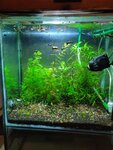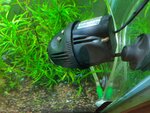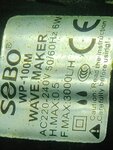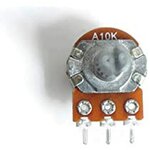kamlesh barot
Newbie
Hi,
For my aquarium hobby at home, I'd purchased the below fan (motor) to circulate the water in my aquarium, for flow. There are two problems I need to request just an approval, if I can go ahead or not.
The first problem is that when I start the AC 220v circulation motor, sometimes it rotates clockwise and sometimes anti-clockwise. When I switch it on and off a couple of times, the desired rotation is achieved.
The second problem is the motor rotates very fast and the entire plants, soil and fish keep getting blown away. It consumes 6 watts per hour, which with the speed control I'd also like to bring down the 6 watts to 2 or 3 watts power consumption, per hour.
I had come across the attached motor controller on amazon, which says it will make the rotation in the correct direction and the speed can be regulated. On the internet I found in a chat that if there's a mistake made, the motor could catch fire, though the motor is immersed inside the water.
I need only some expert on the is forum to read both specs and tell me if it's ok to buy the controller, for my wavemaker motor. Thanks in advance!
Wavemaker motor already installed:
Size:WP-200M
Sobo Wave Maker WP-200M
Sobo Wave Maker WP-200M provides powerful water circulation for strong and consistent flow. Energy Saving and Eco-Friendly, Excellent for both marine and fresh water, Does not overheat and operates quietly, suitable for coral decorations, Also great for waterfalls, fountains, skimmer and multi tank aquariums. High performance with minimum power consumption. It can be easily mounted with its powerful suction cup, Reliable, extremely silent and easy to maintain.
MODEL: WP-200M
Voltage: 220V - 240V
Freq: 50/60Hz
Power: 6W
Amount of water displaced at a height of H.MAX: 0.8m, F.MAX: 5000L/H
Dimensions: 16*10*10
AC motor controller to buy is in the attachment: https://www.amazon.in/gp/product/B01EF2XMMQ/ref=ox_sc_act_title_2?smid=AT95IG9ONZD7S&psc=1
Description of this controller I want to buy: With reverse polarity protection, high current protection high temperature fr-4 circuit board maximum power: 2000w voltage: Ac 110-220v voltage regulation: Ac 50-220v size(lx w): Approx. 46 x 35mm how to use: This product series with the lamp or electrical circuit, table lamps, appliances disconnect any firewire or zero line (ie a "product" two wires connected to both) rotary potentiometer spin rod, you can play light and shade adjustment, speed, pressure, the role of the thermostat, use very convenient. This product is applicable to: The use of new two-way high-power thyristor can be very convenient to adjust the mains current up to 25 a, and solve the the overcurrent problem of the heating wire resistance is too small in the case of cooling causing good, the output voltage is adjusted anywhere between 90 to 220 volts for use with electrical appliances. Such as: Electric stove, water heater tune thermal, lighting dimmer, small motor speed, electric iron thermostat. So as to achieve dimming, thermostats, pressure regulator effect. Large appliances available, power consumption is less than 2, 000 watts of power has sufficient home appliances or small factories. (Inductive or capacitive load power should be reduced, the regulator is equipped with two-way high-power thyristor, potentiometers are with nuts, do not have to add any components will be able to use, very convenient and practical). Package includes: 1x high-power controller.
Thanks,
Kamlesh
For my aquarium hobby at home, I'd purchased the below fan (motor) to circulate the water in my aquarium, for flow. There are two problems I need to request just an approval, if I can go ahead or not.
The first problem is that when I start the AC 220v circulation motor, sometimes it rotates clockwise and sometimes anti-clockwise. When I switch it on and off a couple of times, the desired rotation is achieved.
The second problem is the motor rotates very fast and the entire plants, soil and fish keep getting blown away. It consumes 6 watts per hour, which with the speed control I'd also like to bring down the 6 watts to 2 or 3 watts power consumption, per hour.
I had come across the attached motor controller on amazon, which says it will make the rotation in the correct direction and the speed can be regulated. On the internet I found in a chat that if there's a mistake made, the motor could catch fire, though the motor is immersed inside the water.
I need only some expert on the is forum to read both specs and tell me if it's ok to buy the controller, for my wavemaker motor. Thanks in advance!
Wavemaker motor already installed:
Size:WP-200M
Sobo Wave Maker WP-200M
Sobo Wave Maker WP-200M provides powerful water circulation for strong and consistent flow. Energy Saving and Eco-Friendly, Excellent for both marine and fresh water, Does not overheat and operates quietly, suitable for coral decorations, Also great for waterfalls, fountains, skimmer and multi tank aquariums. High performance with minimum power consumption. It can be easily mounted with its powerful suction cup, Reliable, extremely silent and easy to maintain.
MODEL: WP-200M
Voltage: 220V - 240V
Freq: 50/60Hz
Power: 6W
Amount of water displaced at a height of H.MAX: 0.8m, F.MAX: 5000L/H
Dimensions: 16*10*10
AC motor controller to buy is in the attachment: https://www.amazon.in/gp/product/B01EF2XMMQ/ref=ox_sc_act_title_2?smid=AT95IG9ONZD7S&psc=1
Description of this controller I want to buy: With reverse polarity protection, high current protection high temperature fr-4 circuit board maximum power: 2000w voltage: Ac 110-220v voltage regulation: Ac 50-220v size(lx w): Approx. 46 x 35mm how to use: This product series with the lamp or electrical circuit, table lamps, appliances disconnect any firewire or zero line (ie a "product" two wires connected to both) rotary potentiometer spin rod, you can play light and shade adjustment, speed, pressure, the role of the thermostat, use very convenient. This product is applicable to: The use of new two-way high-power thyristor can be very convenient to adjust the mains current up to 25 a, and solve the the overcurrent problem of the heating wire resistance is too small in the case of cooling causing good, the output voltage is adjusted anywhere between 90 to 220 volts for use with electrical appliances. Such as: Electric stove, water heater tune thermal, lighting dimmer, small motor speed, electric iron thermostat. So as to achieve dimming, thermostats, pressure regulator effect. Large appliances available, power consumption is less than 2, 000 watts of power has sufficient home appliances or small factories. (Inductive or capacitive load power should be reduced, the regulator is equipped with two-way high-power thyristor, potentiometers are with nuts, do not have to add any components will be able to use, very convenient and practical). Package includes: 1x high-power controller.
Thanks,
Kamlesh





